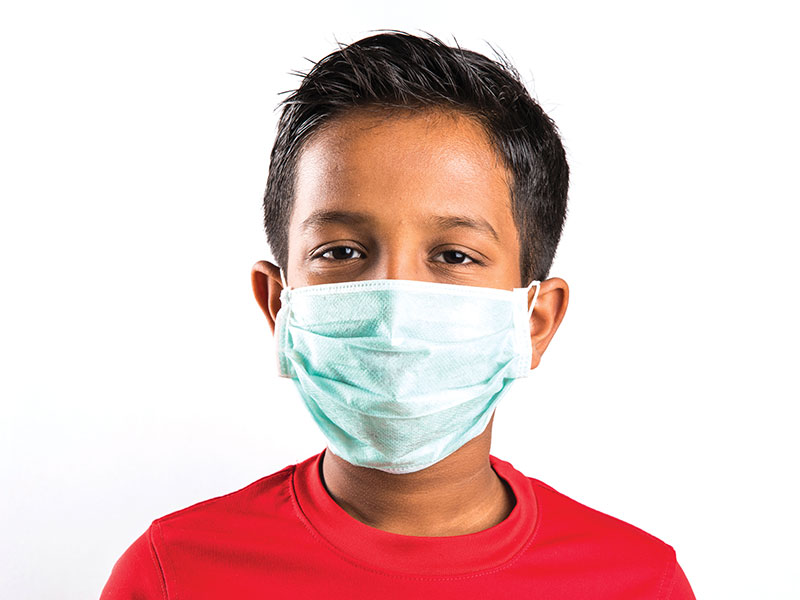Covid-19: Rash, masks & more
 With skin rash listed as one of the symptoms of Covid-19, how does one distinguish between minor and infectious rashes? — Rajini Shri, Chennai
With skin rash listed as one of the symptoms of Covid-19, how does one distinguish between minor and infectious rashes? — Rajini Shri, Chennai
Rashes are very common in children. They can be caused by numerous non-infectious conditions as well as viral and bacterial infections. Infective rashes are usually accompanied by fever. Viral infections such as measles, German measles, chickenpox, hand foot and mouth disease and Covid-19 cause skin rashes which usually surface on the palms and soles in addition to face and other parts of the body. These rashes don’t usually itch although eyes may redden. Some bacterial infections such as typhoid, streptococcus and meningitis also cause rashes. Many rashes triggered by infectious diseases such as measles, German measles, chickenpox and typhoid can be prevented with timely immunisation of children.
Rashes caused by allergies tend to manifest suddenly and all over the body. They cause intense itching and are triggered by consumption of particular foods or contact with plants. Similarly, itchy rashes can occur with worm infestation. Children, especially school-going children, are prone to developing a parasitic skin infestation known as scabies which is highly contagious. Other innocuous but long-lasting rashes may be caused by warts (molluscum contagiosum) or pityriasis rosea.
My advice is that you consult a physician/pediatrician if your child has a rash, especially if it is accompanied by fever. As a temporary relief measure, levocetrizine can be administered, in dosage of 1.25 mg in children aged up to two years, 2.5 mg for years 6-11 and 5 mg thereafter. The dosage is once per day. Calamine lotion and liquid paraffin applied externally can be antidotes.
There are many types of masks available in the market — cloth, N95, disposable, herbal, etc. What do you recommend for a family with young children? — R. Kamatchi, Coimbatore
The coronavirus is transmitted through droplets when an infected person laughs, talks, coughs or sneezes. Depending on the force of expulsion, the droplets can travel a distance of 1-3 meters and infect others through the mouth and nose. A face shield can prevent deposition and ingestion of these droplets.
N95 masks offer the highest level of protection against Covid-19 infection, followed by surgical grade masks. Ideally masks should be changed daily. They are expensive, often have layers of plastic, are not biodegradable, in limited supply, and uncomfortable to wear.
However any face covering, even a scarf, offers some degree of protection. Cloth masks should ideally consist of two rectangles of tightly woven cloth 25×15 cms in size and T-shirt masks should also have two layers. Masks should be tight-fitting and worn over the nose and mouth (not on the forehead or under the chin). Double layers help to remove particles of 0.3-1.0 microns in diameter, the typical size of viruses. Handkerchiefs and bandanas are not tight-fitting enough. Hold the mask by its two ends while putting it on or taking it off. Cloth masks should be washed regularly.
Masks are not advisable for children under the age of two. While exercising, avoid wearing a mask as it makes breathing difficult. Moreover, the sweat makes the mask damp and allows bacteria or viruses that settle on it to grow.
Most important, wash hands often for 30 seconds with sanitizer or one minute with soap and water.
If my child falls sick with flu-like symptoms, what is the first step we should take? We are not comfortable with going to a doctor’s clinic for fear of catching the Covid-19 infection. — Reeba J, Bangalore
First, check your child’s temperature with a thermometer. If the reading is above 100oF, paracetamol (drops, dispersible tablets, syrup) can be administered every four hours. The dose is dependent on weight, not age, and is 10-15 mg/kg/dose. Even paracetamol has side effects, so do not administer without checking and noting the temperature and more frequently than every four hours.
Turning on the fan, removing clothes and then sponging down children with tap water also reduces temperature.
Danger signals which require immediate medical consultation are:
- Temperature over 102o F
- Temperature persisting for more than three days
- Vomiting, diarrhoea
- Lethargy and drowsiness
- Hacking cough and shortness of breath
If your child’s immunisation is up to date (including flu vaccine), she is less likely to fall ill.
(Dr. Gita Mathai is a well-known Vellore-based paediatrician and author of Staying Healthy in Modern India)















Add comment